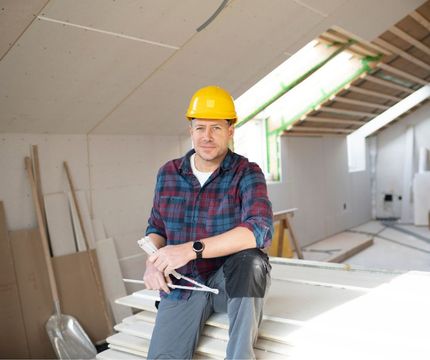Quality Drywall Installation That Changes Your Interiors
Quality Drywall Installation That Changes Your Interiors
Blog Article
Drywall Installment Made Easy: Tips for Perfect Results
Drywall setup is commonly regarded as a difficult job, yet with the ideal technique and knowledge, it can come to be a convenient venture. Understanding strategies for cutting, hanging, and completing drywall can considerably influence the result.
Picking the Right Products
Choosing the proper products for drywall installation is essential to attaining a durable and cosmetically pleasing finish. drywall repair. The primary element, drywall sheets, normally can be found in different densities, with 1/2-inch sheets being standard for indoor walls. For locations calling for additional wetness resistance, such as washrooms or cooking areas, take into consideration making use of eco-friendly board or concrete board, which are particularly created to withstand moisture

Additionally, selecting the best bolts-- either screws or nails-- is important for safeguarding the drywall to the framework. Drywall screws are typically favored for their holding power and reduced risk of standing out. Take into consideration the finishing touches such as primer and paint, which not only improve the appearance but additionally safeguard the drywall from wetness and wear.
Preparing the Setup Location
Prior to beginning the drywall setup procedure, it is important to prepare the setup location thoroughly. This preparation involves a number of critical actions to guarantee a effective and smooth task. First, clear the location of any furniture, home appliances, or obstructions that might hinder access. A clean work area minimizes the risk of damages to existing items and enables for reliable motion throughout setup.
Following, evaluate the walls and ceiling for any type of imperfections, such as fractures, holes, or mold and mildew. Address these problems ahead of time; patch any kind of damages and enable adequate time for repair work to dry. Additionally, make sure that electric outlets, switches, and pipes are properly placed and represented, as this will affect drywall positioning.
Think about the environmental conditions. A secure temperature and humidity level are essential for optimum bond and efficiency of the drywall materials. Make use of a dehumidifier or heating unit to produce suitable conditions. if needed.
Trimming and Hanging Drywall
The trick to effective drywall setup exists in the specific cutting and hanging of the panels. Use a straight side and an utility knife to score the drywall along your measurements, then break it along the racked up line for a tidy break.

Always function from the top down and left to right, making certain that you maintain a staggered pattern to boost security. Appropriately hanging the drywall establishes the foundation for a smooth finish, eventually causing premium results in your drywall task.
Insulation and Mudding Methods
While correct cutting and dangling of drywall sets the phase, the following vital step involves grasping taping and mudding strategies to guarantee a smooth surface. Insulation is important for enhancing joints and stopping cracks; it includes installing tape into the used joint compound (mud) Begin with a quality fiberglass or paper tape, using the tape over the joint and pressing it right into the wet mud making use of a taping knife, guaranteeing no air bubbles continue to be.
As soon as the tape remains in location, use a thin layer of joint substance over the tape, feathering the sides to produce a smooth change to the drywall surface. Enable this layer to completely dry completely before sanding it lightly to eliminate flaws. Repeat this procedure, applying additional layers of mud as required-- normally 2 to 3 coats-- while progressively broadening the application area with each layer to attain a seamless look.
After the last coat dries out, sand the surface area with a fine-grit sandpaper up until smooth. drywall fort worth. Bear in mind to wear a mask throughout sanding to stay clear of breathing in dirt fragments. Understanding these taping and mudding techniques is essential for accomplishing a professional-quality surface in your drywall installment
Finishing Touches for Excellence
Accomplishing a perfect drywall installment surpasses taping and mudding; it finishes in the finishing touches that elevate the general look. These last steps are critical in making sure a professional-grade finish that boosts the visual appeals of your space.
Begin by sanding the dried out joint substance to develop a smooth surface. Utilize a fine-grit sandpaper and a sanding block or post sander for ideal control. Pay index specific attention to edges and edges, as these locations have a tendency to require more meticulous work. After sanding, clean down the walls with a damp cloth to eliminate any dirt bits, guaranteeing a tidy surface area for paint.
Following, apply a primer specifically designed for drywall. This step is necessary, as it aids seal the joint substance and offers a consistent base for the overcoat. When the guide dries out, check for any kind of blemishes, and touch up as required.
Final Thought
In final thought, effective drywall setup rests on the cautious selection of materials, complete preparation of the installment location, and exact execution of cutting and hanging techniques. Proficiency of taping and mudding procedures is essential for accomplishing a smooth finish. Additionally, interest to finishing touches, consisting of priming and touch-ups, makes certain a professional-grade result. By sticking to these standards, the high quality of workmanship can be substantially boosted, adding to the overall visual and capability of the area.
Drywall installation is often viewed as a challenging job, yet with the appropriate method Bonuses and expertise, it can come to be a convenient undertaking.Picking the appropriate materials for drywall installment is critical to accomplishing a sturdy and important source visually pleasing surface.Prior to starting the drywall installment procedure, it is vital to prepare the installation location extensively. Mastering these taping and mudding methods is critical for accomplishing a professional-quality finish in your drywall installation.
In verdict, effective drywall setup hinges on the mindful selection of materials, complete prep work of the installment location, and precise implementation of cutting and hanging strategies.
Report this page